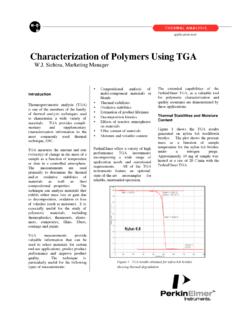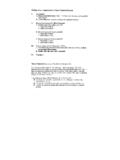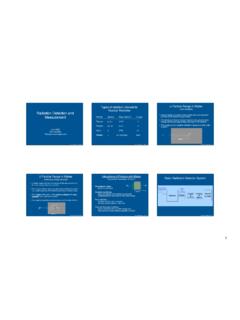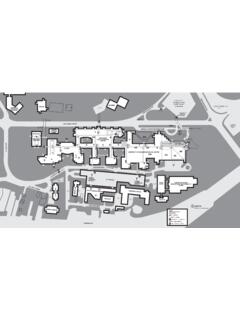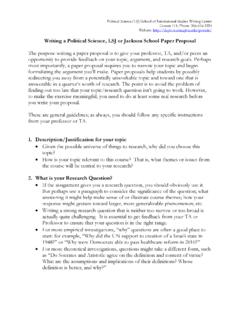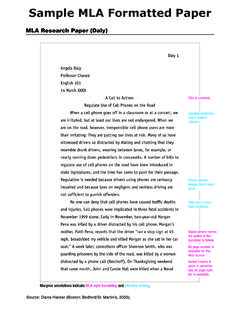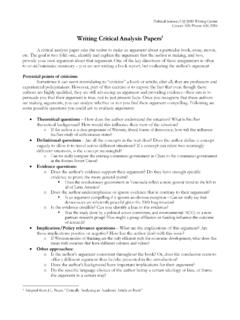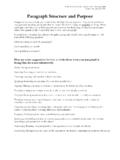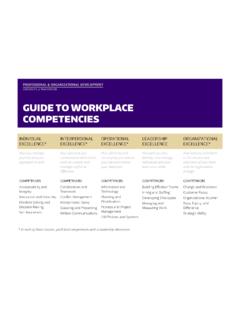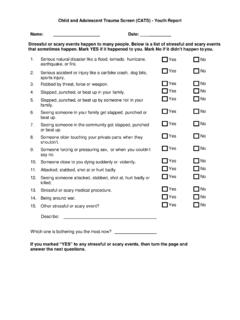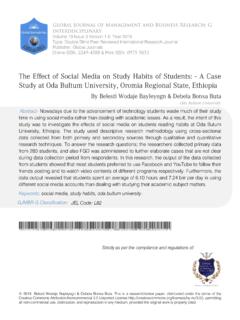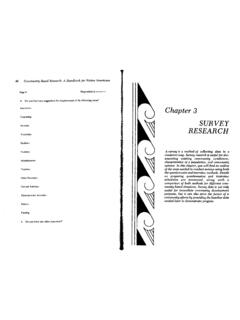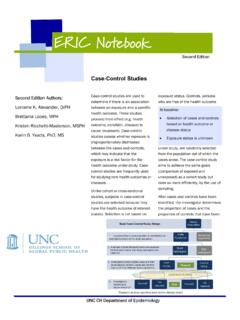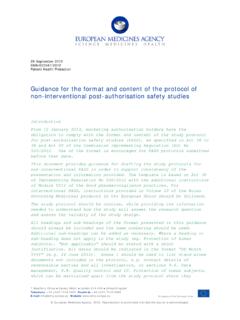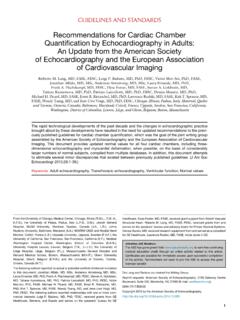Transcription of Developing a Protocol - University of Washington
1 1 Developing a ProtocolQuality of science is often improved when study objectives and methods are clearlythought through and described. A written Protocol facilitates high quality science and is aninvaluable tool to investigators as they develop and conduct of the scientific discipline in which the study is undertaken, the samescientific method is used. Further, while the scientific content will differ across studies, thegeneral elements of the study Protocol will be Excellence in Science committee has developed a general Protocol checklist andcompanion guide to assist scientists in preparing protocols.
2 The checklist is intended as an aid insuggesting a format for writing protocols and in identifying issues that scientists should consideras they design the many scientific disciplines represented by CDC scientists, the checklist wasdeveloped to have utility in conducting laboratory and basic science studies, epidemiologicstudies, and behavioral and social science studies employing a variety of study designs. In usingthe checklist, investigators should select the items that apply to their types of studies. It isunlikely that any Protocol would include every item on the number of studies are conducted at CDC that are not classified as research or do notinvolve humans as participants.
3 To make the checklist applicable to the widest range of studies,the general Protocol checklist does not contain requisite Protocol items for review by aninstitutional review board. A separate addendum checklist for Protection of Human ResearchParticipants is Protocol CHECKLIST This checklist is intended as an aid in suggesting a format for writing protocols and in identifyingissues that scientists should consider as they design a study or surveillance system. When usingthe checklist, investigators should select the items that apply to their specific project. It is notexpected that every item on the checklist is applicable to each Protocol for a study or PROJECT OVERVIEWT itleProtocol summaryInvestigators/collaborators/fundi ng sourcesINTRODUCTIONL iterature review/current state of knowledge about project topicJustification for studyIntended/potential use of study findingsStudy design/locationsObjectivesHypotheses or questionsGeneral approachPROCEDURES/METHODSDESIGNHow study design or surveillance system addresses hypotheses andmeets objectivesAudience and stakeholder participationCost benefit/prevention effectivenessStudy
4 Time lineExpedited Protocol review requestPROCEDURES/METHODSSTUDY POPULATIOND escription and source of study population and catchment areaCase definitionsParticipant inclusion criteriaParticipant exclusion criteriaJustification of exclusion of any sub-segment of the population Estimated number of participantsSampling, including sample size and statistical powerEnrollmentSectionItem 3 PROCEDURES/METHODSVARIABLES/INTERVENTION SV ariablesStudy instruments, including questionnaires, laboratory instrumentsand analytic testsFDA Investigative New Devices (IND) informationIntervention or treatmentOutcomes and minimum meaningful differencesTraining for all study personnelPROCEDURES/METHODSDATA HANDLING ANDANALYSISData analysis plan, including statistical methodology and plannedtables and figuresData collectionInformation management and analysis softwareData entry, editing and management, including handling datacollection forms.
5 Different versions of data and data storage anddispositionQuality control/assuranceHandling results in the absence of a reference testMeasurement/estimation and adjustment for cross reactivityVerifying independence of tests used to confirm results of new testbeing studiedBias in data collection, measurement and analysisIntermediate reviews and analysesLimitations of studyPROCEDURES/METHODSHANDLING OF UNEXPECTEDOR ADVERSE EVENTSR esponse to new or unexpected findings and to changes in the studyenvironment Identifying, managing and reporting adverse eventsEmergency carePROCEDURES/METHODSDISSEMINATION,NOTI FICATION, ANDREPORTING OF RESULTSN otifying participants of their individual resultsNotifying participants of study findingsAnticipated products or inventions resulting from the study and theiruseDisseminating results to publicSectionItem 4 REFERENCESAPPENDIX MATERIALSData collection formsProposed tables and figuresOther relevant documents5 GUIDE FOR GENERAL Protocol CHECKLISTPROJECT OVERVIEWT itle: Summarize the main idea under investigation.
6 The title should be able to stand alone asan explanation of the study . Protocol summary: Give a concise overview of the project. Describe the purpose of the study ,including problem to be investigated and hypothesis(es) to be tested, the population, and themethods that will be used. Avoid the use of acronyms. Include the expected benefit of the sources: Include the names and degrees of all investigatorsand their roles in the project. Note any conflict of interest for each investigator and acknowledgeall funding review/current state of knowledge about project topic: Discuss relevant informationabout the subject of the project based on a review of the literature.
7 In the Reference section,attach a bibliography of the sources for study : Explain the public health and scientific importance of the study . In thecontext of previous studies, describe the contribution this study will use of study findings : Define the primary target audiences and discuss theexpected applicability of study design/locations: Describe the study design and the locations where the study will : Clearly and concisely list the objectives that the project will address. Hypotheses or questions : List the clear and focused question(s) that the study will answer.
8 State the type of hypothesis(es) that will be explored or approach: Describe whether the approach used will be descriptive, exploratory(hypothesis-generating), confirmatory (hypothesis testing), or developmental (focused oncorrective action). PROCEDURES/METHODSDESIGNHow study design or surveillance system addresses hypotheses and meets objectives: Explainthe appropriateness of the study design to the project and to the questions and objectivespreviously outlined. Distinguish between procedures that are experimental and those that involveroutine care. Identify specific design attributes that characterize the study design ( , cross- sectional survey, case/control, cohort, focus group, chart review, etc.)
9 Or surveillance system( , description of the system as active or passive, defining reported cases as individual versusaggregate and as laboratory confirmed or not). 6 Audience and stakeholder participation: Define the primary audiences for the project. Assessthe major stakeholders and describe ways they can (and cannot) participate in the study . Explainthe process by which those affected by the study can express their views, clarify their needs, andcontribute to the benefit/prevention effectiveness: Describe how these measures will be time line: Provide a calendar with estimated dates for implementing and completing Protocol review: If appropriate, describe the need for an expedited review of theprotocol ( , because it is for an ongoing outbreak or emergency disaster).
10 study POPULATIOND escription and source of study population and catchment area: Demographically and interms of the specific public health conditions to be studied, define the population from which theparticipants, sample or surveillance subjects will be drawn and to what population inferences willbe made. Case definitions: Provide descriptions of illness, condition or health event which defines a studyparticipant as having that condition. Participant inclusion criteria: Describe conditions or characteristics applicable to theidentification and selection of participants in the study and the conditions necessary for eligiblepersons to be included.
